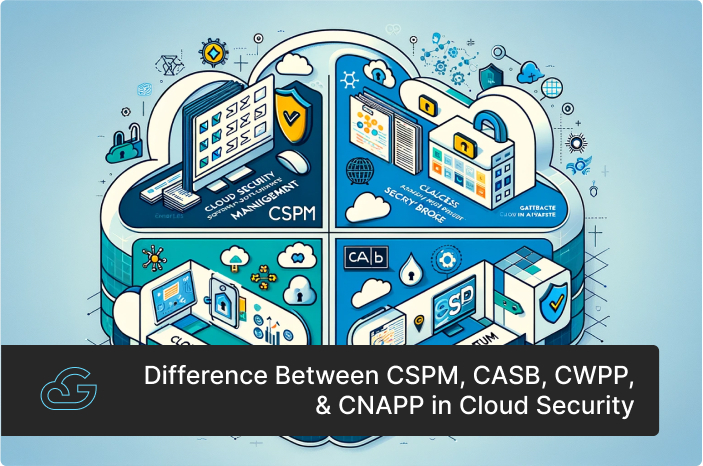Blogs / Cloud Security
Differences Between CSPM, CASB, CWPP & CNAPP in Cloud Security
By
Sherin Job Varghese
Posted: November 15, 2023
• 7 minutes, 15 seconds.
Cloud computing is like a magical wand that can radically transform an organization. With one whoosh (or a click), you can access nearly unlimited storage space, high-powered GPUs, robust networking pipelines, versatile virtual machines (VMs), and beyond.
However, even in the face of all these benefits, one huge concern is holding back IT decision-makers—Cloud Security. According to the latest report by IBM, around 82% of reported data breach incidents involved data stored in cloud environments, with the affected companies incurring an average cost of USD 4.75 million.
These statistics underscore a critical reality: adopting cloud computing alone is insufficient. You must reinforce your cloud environments with robust security solutions, including specialized tools, processes, policies, and mechanisms.
This blog post will comprehensively evaluate four key cloud security solutions—CSPM, CASB, CWPP, and CNAPP—while outlining the crucial differences between each.
Let’s kickstart this blog post by explaining what cloud security is.
What is Cloud Security?
Cloud security refers to the usage of tools, processes, procedures, mechanisms, and controls to ensure the total protection of your cloud environment. It applies to each facet of the cloud computing stack, from network pipelines and storage infrastructure to data and applications.
A key principle in cloud security is the shared responsibility model. This model delineates security responsibilities between the cloud service provider and the customer, ensuring comprehensive protection across all aspects of the cloud environment.
Even though it is fundamentally similar to cybersecurity, cloud security involves unique technologies and best practices specifically designed to cast a sturdy defense against sophisticated threats in the cloud. But what makes cloud security an important element of cloud computing? Let’s go into the details in the next section.
Useful Link: What is Cloud Security? Different Types of Cloud Security Services
Why is Cloud Security Important?
While cloud computing unlocks a whole new level of scalability and cost-effectiveness, it also presents some unique risks and challenges. Common security issues associated with cloud environments stem from infrastructure misconfigurations, lack of visibility, human errors, improper access management, and much more.
To address these challenges, cloud security encompasses several aspects:
- Data Protection: Shielding sensitive information from unauthorized access, breaches, and data loss.
- Access Control: Managing user authentication to prevent unauthorized access to cloud resources.
- Threat Detection and Prevention: Implementing systems to identify and mitigate potential security threats in real time.
- Compliance: Ensuring adherence to regulatory standards and industry-specific requirements.
- Infrastructure Security: Protecting the underlying infrastructure that supports cloud services.
- Application Security: Securing cloud-based applications and APIs from vulnerabilities and attacks.
All these aspects come together to form your cloud security strategy. But to execute this strategy, you need tailored cloud security solutions. In the next sections of this blog post, we will take a closer look at 4 different cloud security solutions—CSPM, CASB, CWPP, and CNAPP.
What is Cloud Security Posture Management (CSPM)?
CSPM is an infrastructure-centric cloud security solution that focuses on identifying and mitigating risks across your complex multi-cloud environments. CSPM tools enable you to continuously monitor and assess cloud resources to pinpoint misconfigurations and ensure adherence to security best practices, compliance regulations, and organizational policies.
These tools also have the capability to automate the detection and remediation of misconfigurations, vulnerabilities, and potential security threats in cloud systems and resources. Some of the best CSPM solutions available in the market are Lacework, Fugue, Prisma Cloud, Checkpoint CloudGuard, etc.
Core Features:
- Continuous monitoring and assessment of cloud infrastructure
- Automated remediation
- Easy integration with other security tools
- Dynamic dashboards and reporting
Despite all these benefits and features, CSPM has some limitations as well. Primarily, it focuses solely on infrastructure and configuration problems while overlooking application-level vulnerabilities. On top of this, you may also face challenges in managing the high volume of alerts generated by CSPM tools, which might even lead to “alert fatigue” if they are not properly managed.
What is Cloud Access Security Broker (CASB)?
CASB is an endpoint-centric cloud security solution that acts as an intermediary or checkpoint between cloud application users and cloud services. CASB tools will help you extend your organization’s security policies to the cloud environment, implementing zero-trust access control and policy enforcement.
On top of this stringent access control and policy enforcement mechanisms, CASB tools can help you gain complete visibility into cloud application usage. This allows you to eliminate data leakage, prevent cyberattacks, block risky sharing of data, and control shadow IT, where users access unauthorized cloud applications.
Additionally, these tools streamline regulatory compliance as they function as a gateway to filter out or block policy infringements. Some of the commonly used CASB solutions are Microsoft Defender for Cloud Apps, Netskope, Symantec CloudSOC, etc.
Core Features:
- Enhanced visibility and discovery of cloud apps
- Data security through advanced encryption
- Data loss prevention and threat protection
- Enhanced compliance management
- Real-time monitoring and analytics
- Anomaly detection
Nonetheless, CASB tools come with certain limitations. Since they predominantly function at the edge of the cloud environment as a gateway, these tools can introduce latency issues, which might slow down your applications. Also, configuring and managing CASB tools demand significant IT expertise and resources, making it a bit tedious.
What is a Cloud Workload Protection Platform (CWPP)?
As the name suggests, CWPP is a workload-centric cloud security solution. That is, it is specifically designed to protect workloads (virtual machines, containers, servers, serverless functions, etc.) in public, private, and hybrid cloud environments. While legacy security tools often lack this level of detail or granularity, CWPP tools can check for vulnerabilities and threats when workloads are deployed.
These tools scan for improperly configured security settings or workloads that violate your organizational policies and promptly notify you. They ensure consistent security coverage across different cloud environments and secure your workloads at runtime with micro-segmentation, intrusion prevention, and much more. Some of the commonly used CWPP solutions are AWS GuardDuty, Illumio Core, Orca Security, etc.
Core Features:
- Workload visibility and discovery
- Vulnerability and threat scanning
- Whitelisting
- Host-based intrusion prevention
- Anti-malware probing
Like all the other cloud security solutions, CWPP also has some limitations that you should know beforehand. One of the major drawbacks is the complexity of deployment, as you will have to deploy tools individually for every asset to be secured, leading to extremely slow deployment times. Another notable disadvantage of CWPP is that since it is too focused on the workload, it lacks the visibility into overall cloud estate, leaving critical elements unguarded. Therefore, you must always use CWPP in conjunction with other security solutions like CSPM or CASB.
What is a Cloud-Native Application Protection Platform (CNAPP)?
CNAPP is an integrated security solution designed specifically for cloud-native applications. By combining the capabilities of other security solutions like CSPM, CWPP, application security, etc., into a single and unified platform, CNAPP provides comprehensive coverage across the entire cloud-native application lifecycle, from deployment to production.
Specifically designed to handle the strong automation requirements and dynamic nature of cloud-native technologies, these tools can identify security threats and vulnerabilities early in development, accelerate remediation, and provide consistent security. They also help organizations secure containerized and serverless applications, which traditional security tools often struggle to protect. Some of the most famous CNAPP solutions are CloudGuard Native Application Protection, Lightspin CNAPP, CrowdStrike Falcon Cloud Security, etc.
Core Features:
- Infrastructure as Code (IaC) scanning
- Cloud Infrastructure Entitlement Management (CIEM)
- Cloud Security Posture Management (CSPM)
- Workload and data protection
- DevOps integration
- Advanced analytics and machine learning capabilities
CNAPP tools are extremely important if you are looking to manage and deploy cloud-native applications. However, one of the major challenges with CNAPP is the steep learning curve it demands for mastering it. Furthermore, as a relatively new solution, CNAPP is still evolving and may not yet offer the same depth of features in all areas.
CSPM vs. CASB vs. CWPP vs. CNAPP: A Comparison
Which One Should You Choose: CSPM, CASB, CWPP, or CNAPP?
Now that you have a complete understanding of different cloud security solutions, you must decide which one to choose for your organization. However, we would like to say that when it comes to cloud security, there is no one-size-fits-all approach. You must carefully analyze your organization’s requirements, infrastructure, and security goals, as each tool addresses different facets of cloud security.
- If your organization is looking to maintain a strong security posture across your cloud infrastructure and if your primary concerns are misconfigurations, compliance, and overall cloud security governance, CSPM should be your go-to solution.
- Similarly, if you are relying heavily on SaaS applications and are concerned about visibility and control over cloud service usage, data protection, and threat prevention for cloud-based apps, CASB is an excellent choice.
- Likewise, if you are managing diverse and dynamic cloud environments with a strong focus on protecting specific workloads, then CWPP is the right choice for you.
- And finally, if you want more comprehensive coverage that combines CSPM, CWPP, and application security to safeguard your cloud-native application lifecycle, CNAPP is the best solution for you.
In many cases, a combination of these tools may be necessary to achieve comprehensive cloud security. Consider starting with the solution that addresses your most pressing security concerns and gradually expanding your security stack as needed.
How Gsoft Ensures Your Organization’s Cloud Security?
At Gsoft, we understand the complexities around cloud security. Our team of cloud experts possesses exceptional knowledge of various cloud security solutions, including CSPM, CASB, CWPP, CNAPP, etc. We work closely with your organization to assess your current cloud infrastructure, identify potential vulnerabilities, and implement the most appropriate security solutions.
Our Cloud Security Service Offerings:
- Customized security assessments and recommendations
- Implementation and integration of leading cloud security tools
- Ongoing monitoring and management of your cloud security posture
- Regular security updates and patch management
- Compliance management and reporting
- 24/7 support from our team of cloud security experts
With Gsoft, you can rest assured that your cloud environment is protected by industry-leading security solutions, allowing you to focus on innovation and growth while we handle the complexities of cloud security.
Are you looking to implement cloud security solutions for your organization? Reach out to us at https://www.gsoftcomm.net/contact-us/.


Get Know More About Our Services and Products
Reach to us if you have any queries on any of our products or Services.











